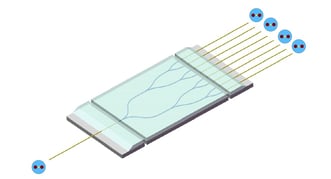FiberLAN in Enterprise: Alternative to an Ethernet-based Market

Local telecommunications networks are essential to the company's operation and allow all users to do their work efficiently and without loss of information.
Also known as Local Area Networks, these are applied in much more than companies. We talk about conglomerates of buildings and infrastructures such as university campuses, hospitals, military facilities, airports, business parks, condominiums, sports complexes and many others. Basically, it is any place where there are people or machines that need to communicate with each other, within a “private” network, before connecting to the world, through the internet.
In this article we will see what Local Area Networks (LAN) are, how they are structured and defined, and we will analyze their evolution towards fiber optic networks and what are the advantages of this new technology.
What are Local Area Networks?
Local computer networks are networks of cables that support telecommunications services and that integrate various transmission media, whether by coaxial, copper, optical fibers cables and/or wireless systems. Its function is to connect several systems and equipment at the same time, independently of the equipment, system or user.
Companies, or other places where these networks exist, are in constant movement: people enter, people leave, companies expand, there are new rooms, new buildings and their users must be connected to this network. The network must follow these movements and cope with them, while maintaining its coherence and capacity. These networks are also called Structured Networks, as they must be properly “structured” so that they can scale up or scale down, while maintaining their transmission capacity without disruptions or interruptions.
The current needs for services and network capacity are introducing a paradigm shifts in relation to what networks must be able to offer:
- Support video, data and voice services.
- Ensure wired or wireless connectivity.
- Allow different accesses and services within the same network.
- Sustainable and environmentally friendly network solutions.
For these and other reasons, networks must be very well designed, allowing flexibility and adaptability, and at the same time, facilitating their maintenance and evolution.
The development of a local network is governed by 3 conflicting premises:
- Develop a network with a limited budget which, at the same time, allows the installation of a future-proof network.
- Develop a fast, functional and secure network, with the latest technology and that allows the monitoring of constant technological evolution.
- Develop a sustainable, environmentally friendly network that uses few resources, both in terms of consumption and maintenance and management.
Traditional Local Area Networks are ethernet copper-pair based networks with various levels of switching. These networks do their job and fulfill their purpose and have been the ideal solution for many years, but the current needs demand more capacity, reliability and security which may be achieved by adopting fiber optic local area networks, using GPON technology, which we call FiberLAN’s.
How do FiberLAN Networks Work?
Fiber Optic local area networks, or FiberLANs, are completely passive networks, which use only optical fibers and optical splitters, with active equipment only at the ends of the network. FiberLANs use GPON technology, which uses a Generic Encapsulation Method (GEM) that supports Ethernet, ATM and TDM transmission, enabling a unified, highly secure network capable of delivering voice, data and video over an optical fiber.
 |
 |
Image of a splitter (left) and principle of work of a PLC module (right)
The terminal equipment installed at the head-end of the network is called an OLT (Optical Line Terminal), and may have 4, 8, 16 or more ports. Each OLT Port can manage up to 128 unique users, using optical splitters throughout the network. Generally, FiberLAN networks use 1:32 split ratios.
The terminal equipment on the user's side is called the ONT (Optical Network Terminals). This is an active equipment, connected to electricity, which transforms the optical signal, transported in the optical fiber, into signals that the equipment can read, such as voice, videos, data, etc.
The ONT can be as far away from the OLT as 20Km, for a 1:32 split ratio network, without the need for any signal regeneration in between.
A single fiber is used to transmit the optical signals between the OLT and the ONT, in which the downstream signals are emitted at a wavelength of 1490nm. The information is encrypted and addressed and only read by the ONT that corresponds to that address. In the Upstream direction, the signals are emitted at a wavelength of 1310nm and uses the principle of Time Division Multiplexing (TDM), in which each ONT sends the information in a defined time slot, thus avoiding the collision of information. for a possible simultaneous sending between two ONT's.
GPON technology defines that the bandwidth in Downstream is 2.5GBps (Gigabit per Second) for each OLT port, divided by the users connected to that port, and in Upstream is 1.25GBps. Bandwidth division is managed by equipment according to the user’s needs, and there are services with QoS (Quality of Service) in which bandwidth is guaranteed.
Comparison Between a Traditional Local Area Network and FiberLAN Network
Here I present a summary of the main features and define each of the networks we are discussing in this article:
Local Area Network:
|
FiberLAN Network:
|
Future Evolution and Development
The trend for applications and services to be physically located off-premises is causing the requirements of LAN networks to differ.
In traditional local networks, the existence of servers and equipment in the premises, the local network was endowed with a lot of internal capacity, and did not need such a strong internet connection. With the emergence of cloud applications, the capacity of the local network and the connection to the world tend to converge.
On the other hand, local networks in companies are increasingly geared towards the use of Wi-Fi wireless systems. As an open-space area is currently supported by a wi-fi connection instead of wired connections, the capacity of the trunk network must increase, which can easily be achieved with the use of FiberLANs.
Final considerations
As mentioned above, with the emergence of cloud based services, local networks tend to become simpler, having to increasingly converge with the operator's internet network.
I foresee that Local Area Networks will become a natural extension of the operator's network, right up to the end-user.
On the other hand, in a world in constant evolution, technological development allows us to have more sustainable and environmentally friendly solutions that allow us to have a better, more inclusive and increasingly connected world. And all thanks to fiber optics!


